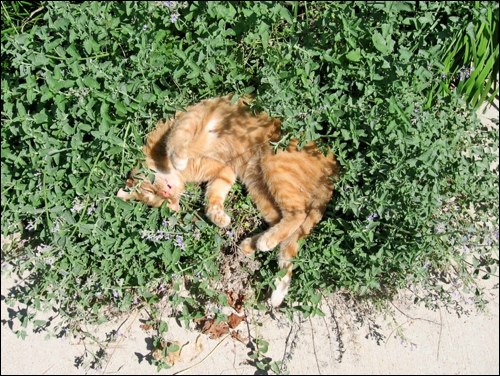Gardeners are seldom neutral when it comes to catmints. Like cats, they generally love them or hate them. Catmint aficionados enjoy their long bloom period, attractive foliage and easy association with other plants – both flowers and foliage “work” in terms of colour, texture and scale and “weaving” diverse plant border plants together. Catmint haters target the invasiveness of a few species, and the perversity of neighbourhood cats attracted to these plants.
Cats may be attracted to the aromatic oil, nepetalactone, that is released when the foliage is crushed. Closely related to feline sexual pheromones, it causes cats to be silly. The effects last for a few minutes, but cats may return frequently, ultimately decimating the plants. Young kittens or older cats are less affected. My own theory, somewhat biased and without scientific support, is city cats really go for it as they’re somewhat bored. Country cats have better things to do with their time and have more options and therefore generally leave it alone.
A member of the mint family, perennial catmint is characterized by four-sided stems and opposite leaves. The oblong to heart-shaped foliage is aromatic and an attractive blue- or grey-green. The small, tubular, two-lipped flowers in blue, purple, white or cream, are arranged in whorls on long racemes. Catmints are floriferous and bloom over six to eight weeks. They attract bees and butterflies with their nectar but are resistant to deer and rabbits.
They’re hardy, easy to grow, and flourish in full sun and well-drained soil. Insect and disease free, they’re remarkably drought-tolerant once established. Shear to about 25 centimetres after blooming.
Here are some selections, beginning with the most compact and well behaved:
Dropmore Blue (30 x 45 centimetre), introduced in 1938 by Dr. Frank Skinner of Manitoba, is my favourite. It sports large, bright blue flowers for almost eight weeks, has attractive blue-green foliage and is well behaved and non-invasive. Because the flowers are sterile, there are no unwanted seedlings. It’s useful in rock gardens, perennial or mixed borders and for edging rose or shrub beds.
Walker’s Low, the 2007 Perennial Plant of the Year, is named for the Irish garden where it was found, not for its height. In fact, it easily reaches a height and spread of 90 centimetres, making it a plant for the mid-border. It has a long blooming period in mid-summer, blue-violet flowers and attractive grey-green foliage.
Junior Walker is a seedling of Walker's Low; it is both sterile (no future seedlings) and smaller (25 x 40 centimetres). The blue-green foliage compliments the lavender-blue flowers that bloom for most of the summer.
Six Hills Giant (one by 1.3 metres) has lavender-blue flowers topping lovely grey foliage. It’s excellent for mass plantings. A sterile hybrid, it flowers prolifically but produces no seedlings. The long racemes make good cut flowers.
Siberian catmint (Nepeta sibirica) forms a large upright plant of 90 centimetres and tends to be invasive. This makes it a poor choice for an average urban yard but excellent for a larger rural landscape that can’t be irrigated but is crying out for a bright splash of summer blue. It grows well by my rural mailbox and in my pasture garden where it is seen and admired from a great distance. Blue Beauty (syn. Souvenir d’ Andre Chaudron) has served me well for almost three decades.
Sara is the author of numerous gardening books, among them the revised Creating the Prairie Xeriscape. And with Hugh Skinner: Gardening Naturally; Trees and Shrubs for the Prairies, and Groundcovers & Vines for the Prairies. Expect Fruit for Northern Gardens with Bob Bors in November, 2017.



